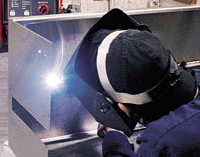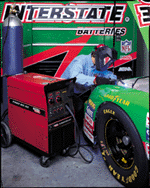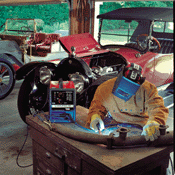MIG Problems and Remedies
Reprinted with permission from the September/October, 1997 issue of Practical Welding Today magazine, copyright 1997 by The Croydon Group, Ltd., Rockford, IL
In much the same way that the automatic transmission has simplified the process of driving, Gas Metal Arc Welding (GMAW) has simplified the process of welding. Of all welding methods, GMAW is said to be one of the easiest to learn and perform. The main reason is because the power source does virtually all the work as it adjusts welding parameters to handle differing conditions; much like the sophisticated electronics of an automatic transmission.
Because less skill is required, many operators are able to GMA weld at an acceptable level with limited training. These same operators run into trouble, however, when they begin creating inferior welds and are unable to diagnose and correct their own problems. The guidelines listed below will help even inexperienced operators create high quality welds as well as offering tips for those who have been using the GMAW process for a number of years.
Most common welding problems fall into four categories:
- Weld porosity
- Improper weld bead profile
- Lack of fusion
- Faulty wire delivery related to equipment set-up and maintenance.
1. Weld Metal Porosity
Porosity Problem #1: Improper Surface Conditions
The most common cause of weld porosity is an improper surface condition of the metal. For example, oil, rust, paint or grease on the base metal may prevent proper weld penetration and hence lead to porosity. Welding processes that generate a slag such as Shielded Metal Arc Welding (SMAW) or Flux-Cored Arc Welding (FCAW) tend to tolerate surface contaminates better than GMAW since components found within the slag help to clean the metal’s surface. In GMAW, the only contamination protection is provided by the elements which are alloyed into the wire.
Remedies
To control porosity, use a deoxidizer within the wire such as silicon, manganese or trace amounts of aluminum, zirconium or titanium. Wire chemistry can be determined by referring to the American Welding Society (AWS) wire classification system.
Test the various types of wire available to find the right chemistry for a given application. To start, try the most common wire type, ER70S-3 (Lincoln L50) which contains 0.9-1.4 percent manganese and 0.45-0.75 percent silicon. If porosity is still present in the finished weld, increase the amount of silicon and manganese found in the wire by switching to an ER70S-4 (Lincoln L54) or an ER70S-6 which has the highest levels of silicon (0.8 -1.15 percent) and manganese (1.4-1.8 percent). Some operators prefer to use a triple deoxidizer such as ER70S-2 (Lincoln L52) which contains aluminum, zirconium or titanium in addition to the silicon and manganese.
In addition to changing the wire, further prevent porosity by cleaning the surface of the metal with a grinder or chemical solvents (such as a degreaser.) A word of caution though if using solvents, be certain not to use a chlorinated degreaser such as trichlorethylene near the welding arc -- the fume may react with the arc and produce toxic gases.
Porosity Problem #2: Gas Coverage
The second leading cause of porosity in welds is a problem with the shielding gas coverage. The GMAW process relies on the shielding gas to physically protect the weld puddle from the air and to act as an arc stabilizer. If the shielding gas is disturbed, there is a potential that air could contaminate the weld puddle and lead to porosity.
Remedies
Shielding gas flow varies depending on wire size, amperage, transfer mode and wind speed. Typical gas flow should be approximately 30-40 cubic feet per hour. Using a flow meter, check that the shielding gas flow is set properly. There are a variety of flow meters on the market today ranging from simple dial gauges to ball flows all the way up to sophisticated, computerized models. Some operators mistakenly think that a pressure regulator is all that is needed, but the pressure meter will not set flow.
A pure carbon dioxide shielding gas requires the use of special flow meters designed specifically for carbon dioxide. These special flow meters are not affected by the frosting that may occur as the carbon dioxide changes from liquid form to a gas.
If high winds are blowing the shielding gas away from the puddle, it may be necessary to erect wind screens. According to the AWS Structural Welding Code, it is advisable not to GMA weld when wind speeds are greater than 5 mph. Indoors, ventilation systems may hamper gas coverage. In this case, redirect air flow away from the puddle. If fume extraction is necessary, use equipment designed specifically for this purpose such as MAGNUM™ Extraction Guns from Lincoln Electric -- they will remove the fume, but not disturb the shielding gas.
A turbulent flow of gas as it exits the gun may also lead to porosity problems. Ideally, the gas will lay over the weld puddle much like a blanket. Turbulent gas flow can be caused by too high a flow, an excessive amount of spatter inside the gun nozzle, or spatter build-up in the gas diffuser.
Other possible causes of insufficient gas flow may be damaged guns, cables, gas lines, hoses or loose gas fittings. These damaged accessories may create what is referred to as a “venturi effect” where air is sucked in through these openings and flow is reduced.
Lastly, welding with a drag or backhand technique can lead to gas coverage problems. Try to weld with a push or forehand technique which lays the gas blanket out ahead of the arc and lets the gas settle into the joint.
Porosity Problem#3: Base Metal Properties
Another cause of weld porosity may be attributed simply to the chemistry of the base metal. For instance, the base metal may be extremely high in sulfur content.
Remedy
Unfortunately, if the problem with porosity lies within the base metal properties, there is not much that can be done. The best solution is to use a different grade of steel or switch to a slag-generating welding process.
2. Improper Weld Bead Profile
If operators are experiencing a convex-shaped or concave-shaped bead, this may indicate a problem with heat input or technique.
Improper Bead Problem #1: Insufficient Heat Input
A convex or “ropy” bead indicates that the settings being used are too cold for the thickness of the material being welded. In other words, there is insufficient heat in the weld to enable it to penetrate into the base metal.
Remedies
To correct a problem with running “too cold,” an operator must first determine if the amperage is proper for the thickness of the material. Charts are available from the major manufacturers, including Lincoln Electric, that provide guidelines on amperage use under varying conditions.
If the amperage is determined to be high enough, check the voltage. Voltage that is too low usually is accompanied by another telltale sign of a problem: a high amount of spatter. On the other hand, if voltage is too high, the operator will have problems controlling the process and the weld will have a tendency to undercut.
One way to check if the voltage is set properly is to test it by listening. A properly running arc will have a certain sound. For instance, in short arc transfer at low amperages, an arc should have a steady buzz. At high amperages using spray arc transfer, the arc will make a crackling sound. The arc sound can also indicate problems -- a steady hiss will indicate that voltage is too high and the operator is prone to undercut; while a loud, raspy sound may indicate voltage that is too low.
Improper Bead Problem #2: Technique
A concave or convex-shaped bead may also be caused by using an improper welding technique. For example, a push or forehand technique tends to create a flatter bead shape than a pull or backhand technique.
Remedy
For best bead shapes, it is recommended to use a push angle of 5-10 degrees.
Improper Bead Problem #3: Inadequate Work Cable
Problems with the work cable can result in inadequate voltage available at the arc. Evidence of a work cable problem would be improper bead shape or a hot work cable.
Remedy
Work cables have a tendency to overheat if they are too small or excessively worn. In replacing the cable, consult a chart to determine size based on length and current being used. The higher the current and longer the distance, the larger the cable needed.
3. Lack of Fusion
If the consumable has improperly adhered to the base metal, a lack of fusion may occur. Improper fusion creates a weak, low quality weld and may ultimately lead to structural problems in the finished product.
Lack of Fusion Problem: Cold Lapping in the Short Arc Transfer Process
In short arc transfer, the wire directly touches the weld pool and a short circuit in the system causes the end of the wire to melt and detach a droplet. This shorting happens 40 to 200 times per second. Fusion problems may occur when the metal in the weld pool is melted, but there is not enough energy left to fuse it to the base plate. In these cases, the weld will have a good appearance, but none of the metal has actually been joined together. Since lack of fusion is difficult to detect visually, it must be checked by dye-penetrant, ultrasonic or bend testing.
Remedies
To guarantee correct fusion, ensure that voltage and amperage are set correctly. If the operator is still having problems after making those adjustments, it may require a change in the welding technique. For example, changing to a flux-cored wire or using the spray arc transfer method instead. In spray arc transfer, the arc never goes out so cold lapping and lack of fusion are not issues. Spray arc welding takes place at amperages high enough to melt the end of the wire and propel the droplet across the arc into the weld puddle.
4. Faulty Wire Delivery
If the wire is not feeding smoothly or if the operator is experiencing a chattering sound within the gun cable, there may be a problem with the wire delivery system. Most of the problems related to wire delivery are attributed to equipment set-up and maintenance.
Faulty Wire Delivery Problem #1: Contact Tip
There is a tendency among operators to use oversized tips, which can lead to contact problems, inconsistencies in the arc, porosity and poor bead shape.
Remedy
Make sure that the contact tip in the gun is in working order and sized appropriately to the wire being used. Visually inspect the tip and if it is wearing out (becoming egg-shaped), it will need to be replaced.
Faulty Wire Delivery Problem #2: Gun Liner
A gun liner, like the contact tip, must be sized to the wire being fed through it. It also needs to be cleaned or replaced when wire is not being fed smoothly.
Remedy
To clean the liner, blow it out with low-pressure compressed air from the contact tip end, or replace the liner.
Faulty Wire Delivery Problem #3: Worn Out Gun
Inside the gun are very fine strands of copper wire that will eventually break and wear out with time.
Remedy
If the gun becomes extremely hot during use in one particular area, that is an indication that there is internal damage and it will need to be replaced. In addition, be certain that the gun is large enough for the application. Operators like to use small guns since they are easy on the hand, but if the gun is too small for the application, it will overheat.
Faulty Wire Delivery Problem #4: Drive Roll
Drive rolls on the wire feeder periodically wear out and need to be replaced.
Remedies
There are usually visual indications of wear on the grooves of the rolls if replacement is necessary. Also, make sure that the drive roll tension is set properly. To check tension, disconnect the welding input cable from the feeder or switch to the cold feed option. Feed the wire and pinch it as it exits the gun with the thumb and forefinger. If the wire can be stopped by pinching, more drive roll tension is needed. The optimum tension will be indicated by feeding that is not stopped while pinching the wire. If the drive roll tension is too high, it may deform the wire leading to birdnesting (tangling) and a burn back (when the arc climbs the wire and fuses the wire to the contact tip).
Make sure that the drive rolls and the guide tube are as close together as possible. Next, check the path from where the wire leaves the reel to where it enters the drive rolls. The wire must line up with the incoming guide tubes so there is no scrapping of the wire as it goes through the tube. On some wire feeders, the wire spool position is adjustable -- align it so that it makes a straight path into the tube.
Faulty Wire Delivery Problem #5: Wire Coming Off Reel and Tangling
Some wire feeding problems occur because the inertia from the wire reel causes it to coast after the gun trigger is released.
Remedy
If the reel continues to coast, the wire on the reel will loosen and the wire may come off or become tangled. Most wire feeding systems have an adjustable brake on the wire reel. The brake tension should be set so that the reel does not coast.
By following these four guidelines, a GMAW operator new to the world of welding or even someone more experienced should have an easier time diagnosing problems before they affect the quality of the work.



